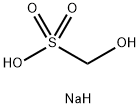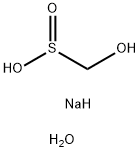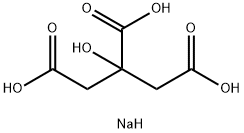Formaldehyde sodium bisulfite
Synonym(s):chromosome 16 open reading frame 57;FLJ13154;HVSL1;PN
- CAS NO.:870-72-4
- Empirical Formula: CH5NaO4S
- Molecular Weight: 136.1
- MDL number: MFCD00044664
- EINECS: 212-800-9
- SAFETY DATA SHEET (SDS)
- Update Date: 2025-12-17 09:50:04

What is Formaldehyde sodium bisulfite?
Chemical properties
white to almost white powder
The Uses of Formaldehyde sodium bisulfite
Formaldehyde Sodium Bisulfite is used in the preparation of oil-soluble sulfonate additives used in improving anticorrosive, dispersant and antioxygenic properties of lubricant oils. Also used in chemical reactions in the preparation of chiral salen Mn(III) catalysts or lignosulfonates as dispersant for gypsum paste.
The Uses of Formaldehyde sodium bisulfite
Formaldehyde sodium bisulfite, is an important raw material and intermediate used in Organic Synthesis, Pharmaceuticals, Agrochemicals and Dyestuff. It also acts as an pharmaceutical intermediate. It can effectively complex metal ion such as Cu, Zn, Pb, co-depositing with nickel ion.
What are the applications of Application
Formaldehyde sodium bisulfite is used in photography (developer) and protects colour pictures exposed to high humidity from fading and staining. It is also used as a textile stripping agent, a colour-fixing agent for keratin-containing fibres, a flotation agent in lead and zinc ores, a preservative in cosmetics and a fungicide in mushroom cultivation. In addition, it is used in foaming agent compositions for civil engineering.
General Description
Formaldehyde-sodium bisulfite adduct is used as a standard in the synthesis of 3-Hydroxypropionaldehyde (3HPA). It can be assayed by HPLC with fluorometric detection in selected foods.
Properties of Formaldehyde sodium bisulfite
| Melting point: | 200 °C (dec.)(lit.) |
| Flash point: | 184 °C |
| storage temp. | Inert atmosphere,Room Temperature |
| solubility | Methanol (Slightly, Heated), Water (Slightly) |
| form | Powder |
| color | White to almost white |
| Water Solubility | 800 g/L (20 ºC) |
| Sensitive | Hygroscopic |
| Merck | 14,4236 |
| CAS DataBase Reference | 870-72-4(CAS DataBase Reference) |
| EPA Substance Registry System | Methanesulfonic acid, hydroxy-, monosodium salt (870-72-4) |
Safety information for Formaldehyde sodium bisulfite
| Signal word | Warning |
| Pictogram(s) |
 Exclamation Mark Irritant GHS07 |
| GHS Hazard Statements |
H303:Acute toxicity,oral |
| Precautionary Statement Codes |
P270:Do not eat, drink or smoke when using this product. P301+P312:IF SWALLOWED: call a POISON CENTER or doctor/physician IF you feel unwell. P403:Store in a well-ventilated place. |
Computed Descriptors for Formaldehyde sodium bisulfite
Formaldehyde sodium bisulfite manufacturer
Imperial Chem Incorporation
New Products
4,4-Difluoropiperidine hydrochloride tert-butyl 9-methoxy-3-azaspiro[5.5]undecane-3-carboxylate Indole Methyl Resin N-Isopropylurea N,N-Dicyclohexylcarbodiimide(DCC) MELDRUMS ACID 5-METHYLISOXAZOLE-4-CARBOXYLIC ACID Magnessium Bis glycinate Zinc ascorbate 1-bromo-2-butyne 2-acetamidophenol 9(10H)-anthracenone Erythrosin B, 4-Piperidinopiperidine 2-((4-morpholinophenylamino) (methylthio) methylene) malononitrile 2,4-dihydroxybenzaldehyde 3-(4-morpholinophenylamino)-5-amino-1H-pyrazole-4-carbonitrile Methyl 2-methylquinoline-6-carboxylate 2,6-dichloro-4-nitropyridine 4-Bromo-2-chlorobenzonitrile 2-(benzylamino)acetic acid hydrochloride 4-(tert-Butoxycarbonylamino)but- 2-ynoic acid 3,4-dihydro-2H-benzo[b][1,4]dioxepine 1-Phenyl-1-cycloprppanecarboxylicacidRelated products of tetrahydrofuran








You may like
-
 Sodium formaldehyde bisulphite CAS 870-72-4View Details
Sodium formaldehyde bisulphite CAS 870-72-4View Details
870-72-4 -
 Sodium hydroxymethanesulfonate 95.00% CAS 870-72-4View Details
Sodium hydroxymethanesulfonate 95.00% CAS 870-72-4View Details
870-72-4 -
 Anti-C16orf57 antibody produced in goat CASView Details
Anti-C16orf57 antibody produced in goat CASView Details -
 SODIUM FORMALDEHYDE BISULFITE CAS 870-72-4View Details
SODIUM FORMALDEHYDE BISULFITE CAS 870-72-4View Details
870-72-4 -
 Sodium Formaldehyde Bisulphite 45% Solution, CH4NaO4S+, 870-72-4View Details
Sodium Formaldehyde Bisulphite 45% Solution, CH4NaO4S+, 870-72-4View Details
870-72-4 -
 Sodium Formaldehyde Bisulphite 45% SolutionView Details
Sodium Formaldehyde Bisulphite 45% SolutionView Details
870-72-4 -
 Sodium Formaldehyde BisulfiteView Details
Sodium Formaldehyde BisulfiteView Details
870-72-4 -
 Sodium Formaldehyde BisulfiteView Details
Sodium Formaldehyde BisulfiteView Details
870-72-4
